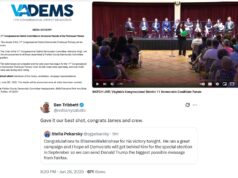 Variations of the above myth include: “Tom Perriello only won becaues of Obama's 2008 coattails;” or “Tom Perriello only won because Virgil Goode was corrupt/particularly egregious, etc.;” or “Tom Perriello is a proven loser.”
Variations of the above myth include: “Tom Perriello only won becaues of Obama's 2008 coattails;” or “Tom Perriello only won because Virgil Goode was corrupt/particularly egregious, etc.;” or “Tom Perriello is a proven loser.”
First of all, Tom outperformed Obama. Tom received 50.8% of the electorate with 158,810 votes; Obama received 48.29% with 157,362 votes. Now that said, its undeniable that Barack Obama’s campaign complemented the work of the congressional campaign, both in terms of student involvement and turnout at Longwood and the University of Virginia, as well as through improved turnout amongst African American communities in Southside. However, Tom had his own machine that pushed him past even Obama’s turnout. From early on, his campaign took a unique approach to community interaction and involvement that made him recognizable, relatable, and likeable to the folks in each town he visited. This energy and commitment went right up to the last day, where Tom’s GOTV and election-day poll work dominated any effort by the Goode campaign. People voted for Tom because they knew, respected, and liked him, and that was wholly independent from being the “D” below Mark Warner and Barack Obama.
As for those who rag on him for losing the second time around, the numbers speak for themselves. The man lost by 3.83% in a deeply conservative and rural area (the district is rated by Charlie Cook as PVI +5R). This loss occurred in the worst Republican sweep in generations, where the RCP average had Republicans winning the generic ballot by 9.8%. And all of this happened while Tom appeared with the President, and voted with some of the most controversial and important initiatives, including the Stimulus, Health Care Act, and American Clean Energy and Security Act. That does not come from luck, a bad Republican candidate, or good coattails, but from earning the respect and admiration of constituents of all shapes and sizes.
I’ll admit, examining Tom’s electoral success does deserve more analysis than what is briefly presented here. I still intend to more deeply explore his performance, especially as it compares to VA02 and VA11, as well as comparing it to previous Democratic performance in the 5th. Unfortunately, my lack of consistent internet while traveling, coupled with my desire to respond quickly to a reference to this myth in David Catanese’s piece, forced me to get this out sooner than I had hoped. Nonetheless, I’ve found that contextual comparisons show that Tom even outperformed what would be immediately suggested by this brief introduction.

 Sign up for the Blue Virginia breaking news newsletter
Sign up for the Blue Virginia breaking news newsletter









